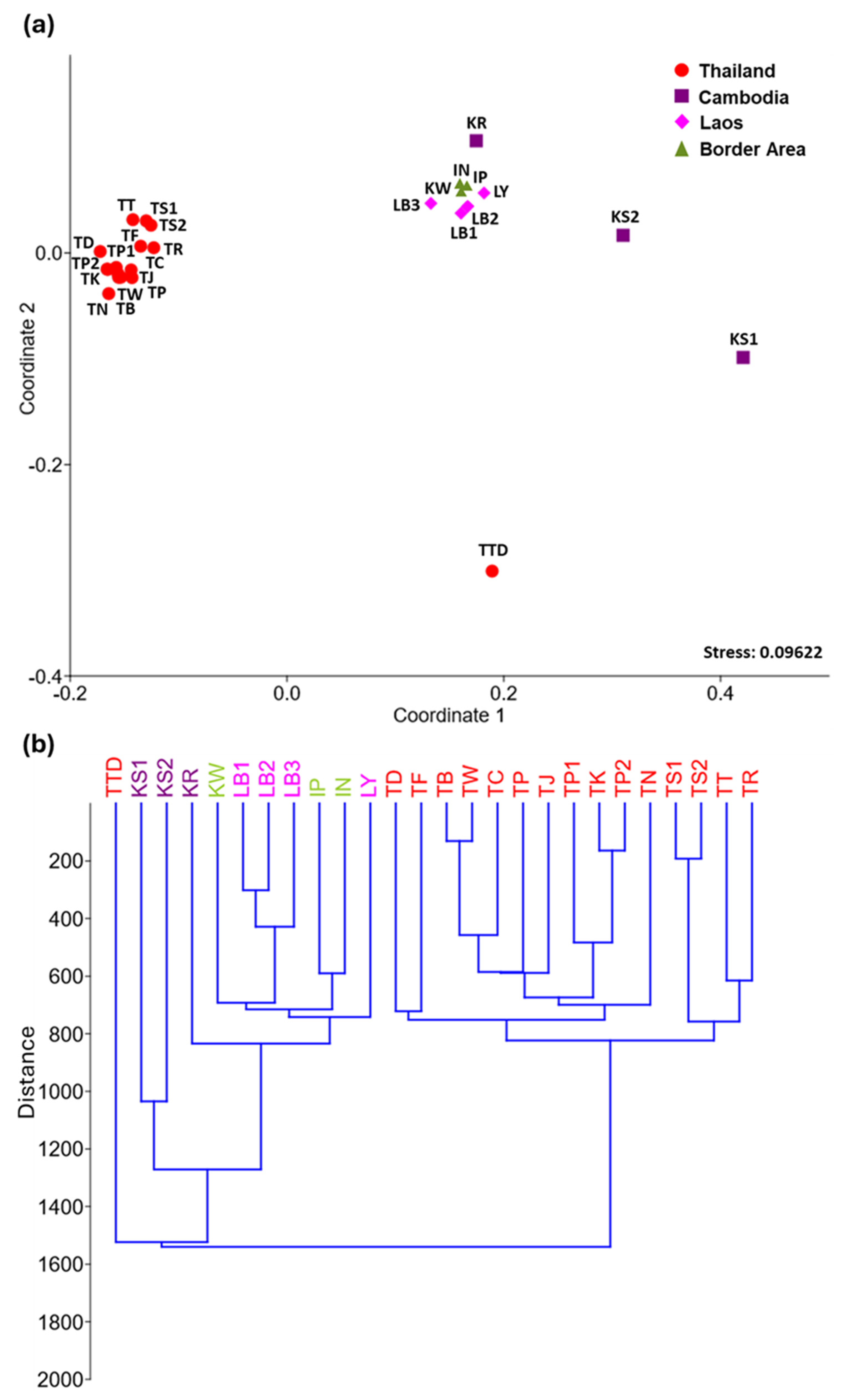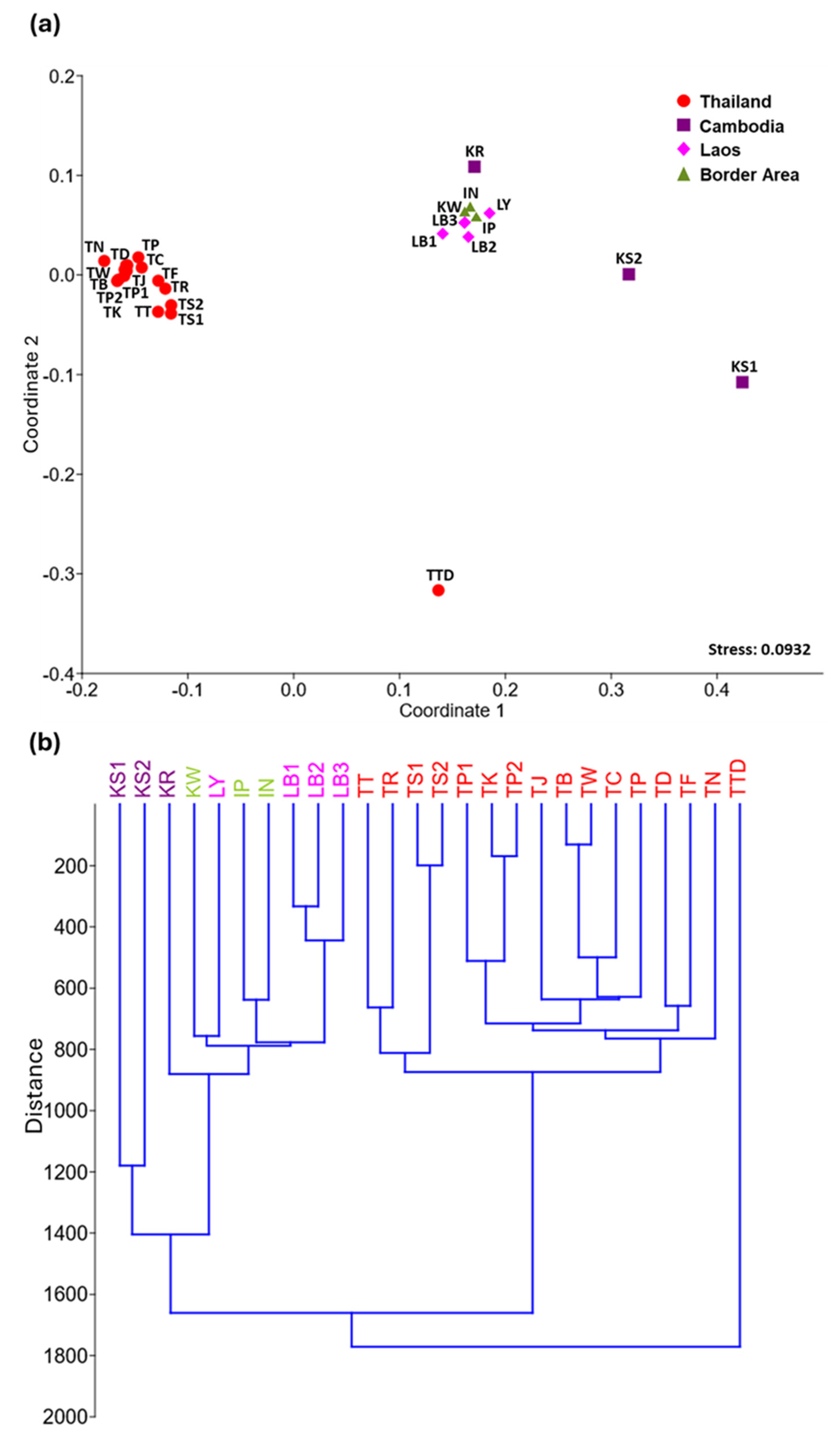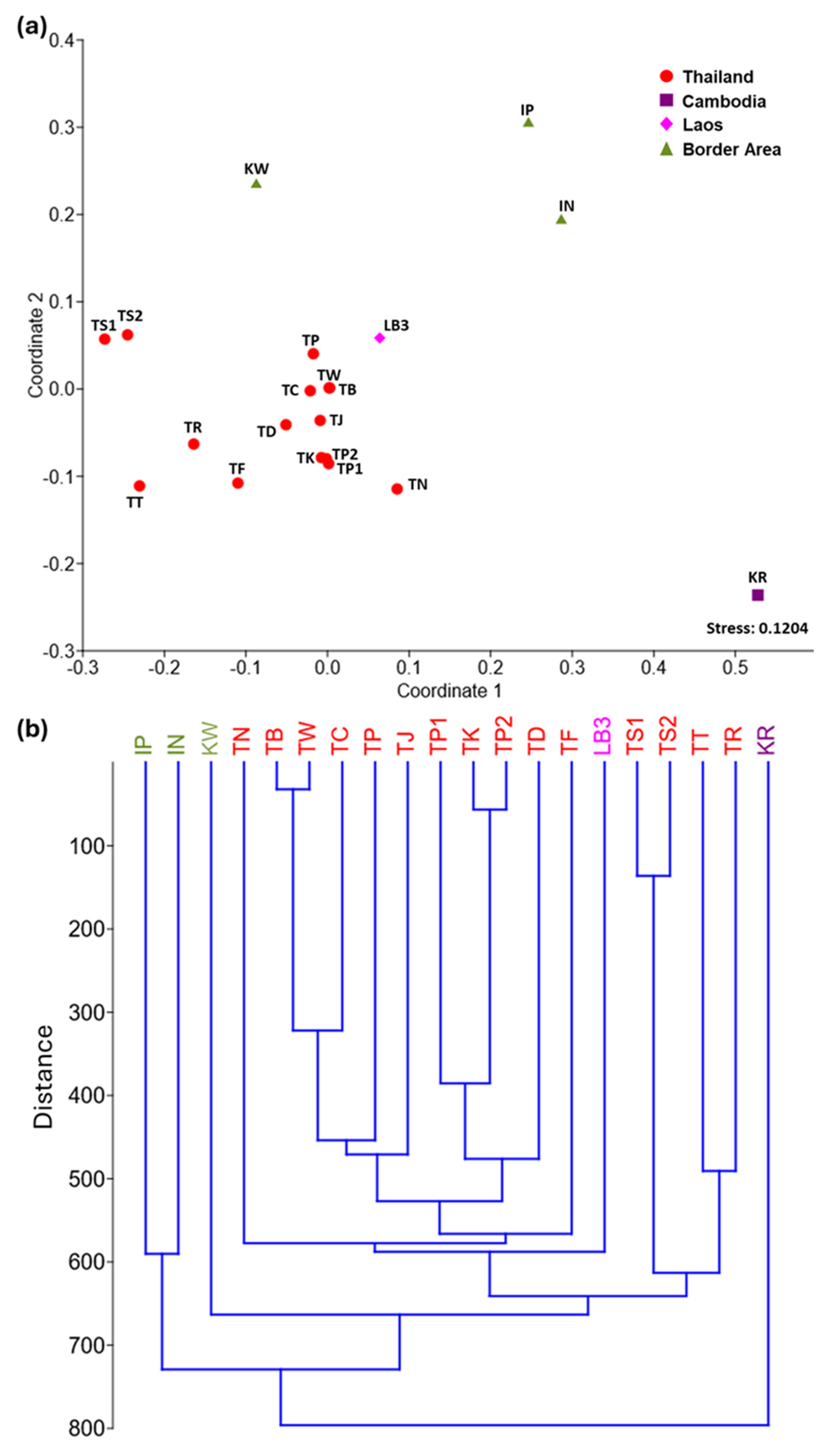Potential Note Degree of Khong Wong Yai Based on Rhyme Structure and Pillar Tone as a Novel Approach for Musical Analysis Using Multivariate Statistics: A Case Study of the Composition Sadhukarn from Thailand, Laos, and Cambodia
Abstract
1. Introduction
2. Material and Method
2.1. The 26 Versions of the Composition Sadhukarn from Thailand, Laos, and Cambodia
2.2. Potential Note Degrees of Khong Wong Yai
2.3. Statistics
3. Results
3.1. Successful Identification of the Countries of Origins and Their Relations of Composition Sadhukarn Using Full Versions of Datasets Derived from Potential Note Degree of Khong Wong Yai
3.2. Impact of Normalization on the Results Obtained by This New Method Based on Potential Note Degree of Khong Wong Yai
4. Discussion
4.1. Comparison of Multivariate Results Obtained by the New Method Developed in This Study and the Published Method Using Manual Conversion
4.2. Normalization: Losses of Identity and Uniqueness
4.3. Application and Future Perspectives
Supplementary Materials
Funding
Institutional Review Board Statement
Informed Consent Statement
Data Availability Statement
Acknowledgments
Conflicts of Interest
References
- Härdle, W.; Simar, L. Applied Multivariate Statistical Analysis, 5th ed.; Springer Nature: Cham, Switzerland, 2019; ISBN 978-3-030-26005-7. [Google Scholar]
- Chi, Y. Multivariate Methods. Wiley Interdiscip. Rev. Comput. Stat. 2012, 4, 35–47. [Google Scholar] [CrossRef]
- Georges, P. Western Classical Music Development: A Statistical Analysis of Composers Similarity, Differentiation and Evolution. Scientometrics 2017, 112, 21–53. [Google Scholar] [CrossRef] [PubMed]
- Purahong, W.; Wubet, T.; Lentendu, G.; Schloter, M.; Pecyna, M.J.; Kapturska, D.; Hofrichter, M.; Krüger, D.; Buscot, F. Life in Leaf Litter: Novel Insights into Community Dynamics of Bacteria and Fungi during Litter Decomposition. Mol. Ecol. 2016, 25, 4059–4074. [Google Scholar] [CrossRef] [PubMed]
- Ramette, A. Multivariate Analyses in Microbial Ecology. FEMS Microbiol. Ecol. 2007, 62, 142–160. [Google Scholar] [CrossRef] [PubMed]
- Eambangyung, S.; Schwörer-Kohl, G.; Purahong, W. DNA of Music: Identifying Relationships among Different Versions of the Composition Sadhukarn from Thailand, Laos, and Cambodia Using Multivariate Statistics. Data 2024, 9, 50. [Google Scholar] [CrossRef]
- Kroonenberg, P.M. Musical Stylometry: Characterisation of Music. In Multivariate Humanities; Kroonenberg, P.M., Ed.; Springer International Publishing: Cham, Switzerland, 2021; pp. 347–370. ISBN 978-3-030-69150-9. [Google Scholar]
- Solomon, M. Multivariate Analysis of Korean Pop Music Audio Features; Bowling Green State University: Bowling Green, OH, USA, 2021; ISBN 979-8-5160-7552-0. [Google Scholar]
- Conrad, C.; Wagner, C.; Nathan, E.; Xu, X.; Frazier, T.; Rui, M. Identification and Multivariate Analysis of 16 Compositional Elements of Relaxation. medRxiv 2023, 2023-08. [Google Scholar] [CrossRef]
- Eambangyung, S.; Schwörer-Kohl, G.; Purahong, W. Manual Conversion of Sadhukarn to Thai and Western Music Notations and Their Translation into a Rhyme Structure for Music Analysis. Data 2022, 7, 150. [Google Scholar] [CrossRef]
- Wong, D. Sounding the Center: History and Aesthetics in Thai Buddhist Performance; The University of Chicago Press: Chicago, IL, USA, 2001; ISBN 0-226-90585-3. [Google Scholar]
- Wisuttipat, M. Pipat Traditions in Music Culture in the Mekong River Basin: Practice and Phenomena in the Early 21st Century. Fine Arts J. Srinakharinwirot Univ. 2014, 18, 12–22. [Google Scholar]
- Srikongmuang, D. Character and Expressivity in the Sacred Naphat Music of Thailand. Ph.D. Thesis, University of York, York, UK, 2019. [Google Scholar]
- Pidokrajt, N. Encyclopedia of Thai Music, 1st ed.; Mahidol University Press: Nakhon Prathom, Thailand, 2014; ISBN 978-616-279-514-5. [Google Scholar]
- Pidokrajt, N. Sadhukarn: Analysis of Gong Wong Yai Melody. Master’s Thesis, Mahidol University, Nakhon Prathom, Thailand, 1991. [Google Scholar]
- Young, R.W. Terminology for Logarithmic Frequency Units. J. Acoust. Soc. Am. 1939, 11, 134–139. [Google Scholar] [CrossRef]
- Hammer, Ø.; Harper, D. PAST Paleontological Statistics; Version 4.11; Reference Manual; Natural History Museum University of Oslo: Oslo, Norway, 2022. [Google Scholar]
- Hammer, Ø.; Harper, D. PAST Paleontological Statistics; Version 2.17; Reference Manual; Natural History Museum University of Oslo: Oslo, Norway, 2012; p. 229. [Google Scholar]
- Taguchi, Y.-H.; Oono, Y. Relational Patterns of Gene Expression via Non-Metric Multidimensional Scaling Analysis. Bioinformatics 2005, 21, 730–740. [Google Scholar] [CrossRef]
- Miller, T.E. The Theory and Practice of Thai Musical Notations. Ethnomusicology 1992, 32, 197–221. [Google Scholar] [CrossRef]
- Royal Institute of Thailand. สารานุกรมศัพท์ดนตรีไทย ภาคคีตะ—ดุริยางค์: ฉบับราชบัณฑิตยสถาน—Sārānukrom sap dontrī Thai phāk khīta-duriyāng: Chabap Rātchabandittayasathān [Encyclopedia of Thai musical terms in part of vocal and instrumental music by Royal Institute of Thailand], 2nd ed.; Royal Institute of Thailand: Bangkok, Thailand, 2002; Volume 1, ISBN 974-8122-90-5.






| Number | Name of Version [Abbreviation] | Location |
|---|---|---|
| 1 | Thai Fine Arts Department [TF] | Bangkok, Thailand |
| 2 | Luang Bamrung Chit Chareon [TB] | Bangkok, Thailand |
| 3 | Samran Kerdphol I [TS1] | Ayutthaya, Thailand |
| 4 | Pinij Chaisuwan I [TP1] | Ayutthaya, Thailand |
| 5 | Thai music ensemble of Bangkok [TK] | Bangkok, Thailand |
| 6 | Chub Sowat [TC] | Ayutthaya, Thailand |
| 7 | Chue Dontrirod [TD] | Ayutthaya, Thailand |
| 8 | Tuen Phatayakul [TP] | Phetchaburi, Thailand |
| 9 | Thawin Attakisna [TT] | Ayutthaya, Thailand |
| 10 | Pinij Chaisuwan II [TP2] | Ayutthaya, Thailand |
| 11 | Rasi Phumthongsuk [TR] | Bangkok, Thailand |
| 12 | Siri Nakdontri [TN] | Samut Songkhram, Thailand |
| 13 | Sangobsuek Thamviharn [TW] | Bangkok, Thailand |
| 14 | Samran Kerdphol II [TS2] | Ayutthaya, Thailand |
| 15 | Subin Chankeaw [TJ] | Sing Buri, Thailand |
| 16 | Sadhukarn Chan Dio [TTP] | Ayutthaya, Thailand |
| 17 | Keo Sonankavai I [KS1] | Phnom Penh, Cambodia |
| 18 | Keo Sonankavai II [KS2] | Phnom Penh, Cambodia |
| 19 | Royal University of Fine Arts [KR] | Phnom Penh, Cambodia |
| 20 | Ban Pang Lang [IP] | Sa Kaeo, Thai–Cambodian border areas |
| 21 | Ban Nong Sai [IN] | Buriram, Thai–Cambodian border areas |
| 22 | Boonthieng Sisackda I [LB1] | Vientiane, Laos |
| 23 | Boonthieng Sisackda II [LB2] | Vientiane, Laos |
| 24 | Boonthieng Sisackda III [LB3] | Vientiane, Laos |
| 25 | Boonyadech Meunsanit [LY] | Luang Prabang, Laos |
| 26 | Wat Reach Bo Pinpeat ensemble [KW] | Siem Reap, Cambodian–Thai border areas |
Disclaimer/Publisher’s Note: The statements, opinions and data contained in all publications are solely those of the individual author(s) and contributor(s) and not of MDPI and/or the editor(s). MDPI and/or the editor(s) disclaim responsibility for any injury to people or property resulting from any ideas, methods, instructions or products referred to in the content. |
© 2024 by the author. Licensee MDPI, Basel, Switzerland. This article is an open access article distributed under the terms and conditions of the Creative Commons Attribution (CC BY) license (https://creativecommons.org/licenses/by/4.0/).
Share and Cite
Eambangyung, S. Potential Note Degree of Khong Wong Yai Based on Rhyme Structure and Pillar Tone as a Novel Approach for Musical Analysis Using Multivariate Statistics: A Case Study of the Composition Sadhukarn from Thailand, Laos, and Cambodia. Stats 2024, 7, 1513-1526. https://doi.org/10.3390/stats7040089
Eambangyung S. Potential Note Degree of Khong Wong Yai Based on Rhyme Structure and Pillar Tone as a Novel Approach for Musical Analysis Using Multivariate Statistics: A Case Study of the Composition Sadhukarn from Thailand, Laos, and Cambodia. Stats. 2024; 7(4):1513-1526. https://doi.org/10.3390/stats7040089
Chicago/Turabian StyleEambangyung, Sumetus. 2024. "Potential Note Degree of Khong Wong Yai Based on Rhyme Structure and Pillar Tone as a Novel Approach for Musical Analysis Using Multivariate Statistics: A Case Study of the Composition Sadhukarn from Thailand, Laos, and Cambodia" Stats 7, no. 4: 1513-1526. https://doi.org/10.3390/stats7040089
APA StyleEambangyung, S. (2024). Potential Note Degree of Khong Wong Yai Based on Rhyme Structure and Pillar Tone as a Novel Approach for Musical Analysis Using Multivariate Statistics: A Case Study of the Composition Sadhukarn from Thailand, Laos, and Cambodia. Stats, 7(4), 1513-1526. https://doi.org/10.3390/stats7040089






